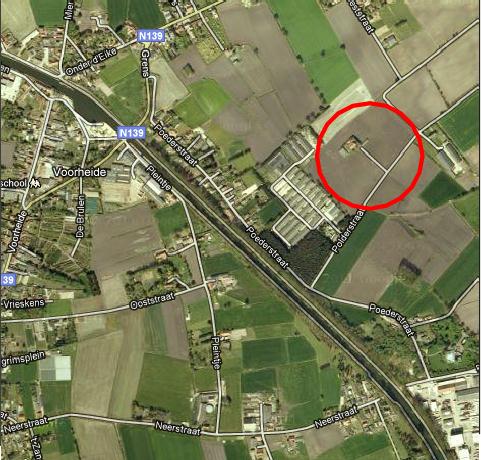The Loss of R5794

Information received from Gil Geerings who is studying the loss of Manchester R5794
A year ago an old man contacted me because he witnessed the crash/landing of this plane.
His father helped the two survivors and tried to hide them from the Germans, but the airmen declined. They knew the Germans won't let them get away that easily and wouldn't risk the lives of the locals.
Meanwhile a young man entered the plane while it was burning and grabbed some items out of it. He saw some dead aircrew and heard a man moaning. He tried to help him but he was burned alive, he couldn't get out in time. So he obtained a compass and some parachute equipment.
Sadly ten years ago his house burned down and he lost most of these items. He still had one parachute hook. He wanted me to search for relatives and give them that parachute hook; it's a small item but with so much emotional value….
You can understand why they chose that place. It was a wide open area. Sadly it was close to the border where a lot of Germans where.
49Sqn Researcher note:
R5794 was shot down by Fw Heinz Pahler of 2./NJG1 at 02.08hrs, his third Abschuss. This ties in with the RT SOS transmission at 02.18, claiming the starboard engine was u/s.
Further details received from Gil Geerings
On Monday 1 June, 1942, 956 planes left on a bombing mission to Essen. 31 planes would not return from this mission. 8 planes crashed on Belgium soil. One of them was Manchaster R5794, 1 of 8 Manchesters from 49 Squadron.
Manchester R5794 was used by the Conversion Training Section which had just been formed. The aircraft had completed 137 hours prior to his last flight. The crew was posted on 26th April 1942 to the squadron except for Sergeant Nolan, who already was posted to the squadron on 1st November 1941 and who by that time had flown 15 operations on Hampdens.
The bombing of Essen proved to be very scattered. Mainly due to the ground haze and layers of low cloud crews had difficulty in finding the target. At 0219 hours, a transmission was received at Scampton. It was an SOS distress signal from the returning Manchaster R5794. Wireless operator Shannon had sent a message that they were under attack by a night fighter. The starboard engine was hit. It had caught fire and was no longer serviceable. A fix was given and nothing further was received.
The plane came trough the clouds and followed the channel Dessel - Turnhout. They quickly saw a wide open space suitable for there crash landing. They flew right towards the farm of family Smets located in the Polderstraat in Arendonk Belgium. The plane hit the tops of some oak trees, plunged into the field and slide towards the farm. The nose of the plane came to a stop at the water reservoir which was standing behind the farmhouse. The fuselage was laying against the back of the house and its right wing lay on top of the roof. Some of the smaller buildings were damaged but it was a wonder that the house wasn't touched by the Manchester.
Four crew members died on impact. Sgt Nolan and Sgt Shannon survived and got out of the plane. One crew member also survived the hard landing but was trapped between a barn and the fuselage. He burned alive.
The daughter of the family Smets remembers, "We were of course all awake and we were getting downstairs to get out, but someone knocked on the front door even before we reached it. It was two airman who were standing there in front of us. One was wounded, blood was on his face, and he was leaning on his friend's shoulder. The wounded man was laid down on the straw and I had the opportunity to dress his wounds. We washed the blood off his face, which was covered with cuts and bruises. He came from Australia, so he told us."
The plane was on fire and ammunition was exploding. From everywhere people came to see the aircraft including some Germans who were stationed nearby. Arendonk is close to an important channel and near the border with The Netherlands so many Germans saw the plane in trouble.
Some local people initially tried to hide them from the oncoming Germans, but finally the airmen declined. They knew the Germans wouldn't let them get away that easily and would not risk their lives and those of the local people.
Sergeant Nolan was brought away as prisoner of war, and Sergeant Shannon was put on a stretcher. He offered the Germans a cigarette but none of them responded. A doctor "Jan Op De Beeck" came to see Shannon and applied first aid. Shannon was then taken away. Mr. Smets, the farmer, was ordered by the Germans to take away the five airmen who had died with his horse and cart. He also had to pick up a dead Polish airmen from Wellington R1615 of No 301 sqn, which had crashed a night earlier in the neighbourhood. They were all buried on the 4th June at the military cemetery at Voorheide next to the French soldiers who had been killed in 1940. The British men were reburied at Heverlee War Cemetery after the war and the Polish men where brought to Lommel.
After the war, the farm was rebuild and the site has changed a lot since then. Nothing reminds of what once happened there, but up until five years ago was there still some oil floating in the brook which runs along side of the field.
Sources used:
"Lancaster verliezen in België" by Govaerts Wim
Mr. Hendrickx, eyewitness
